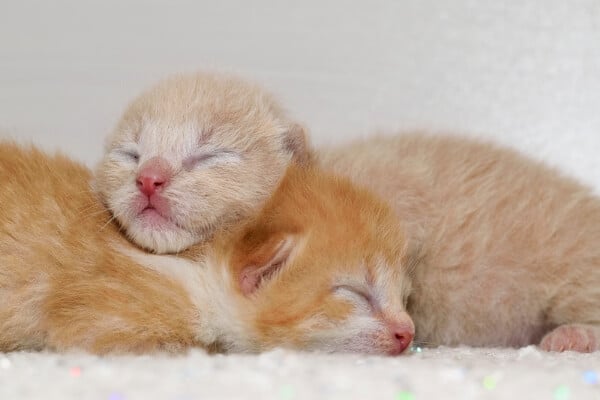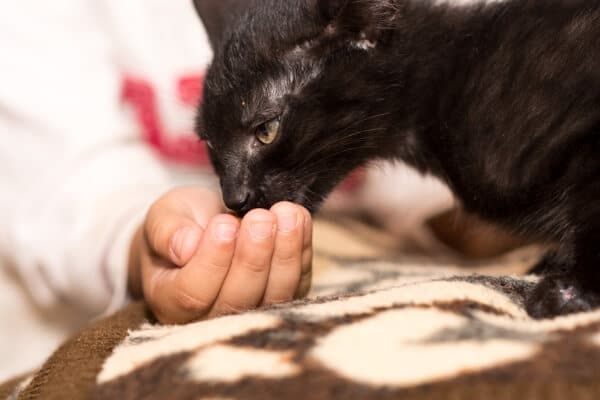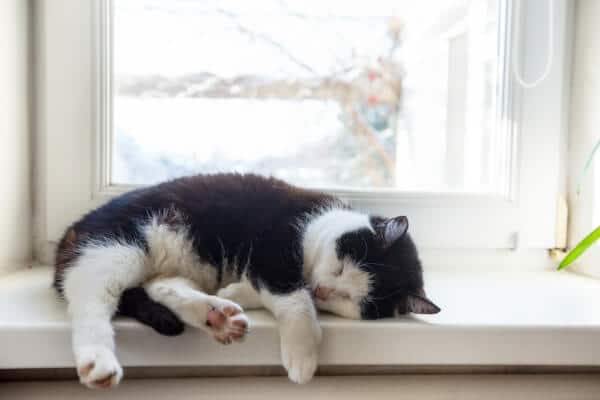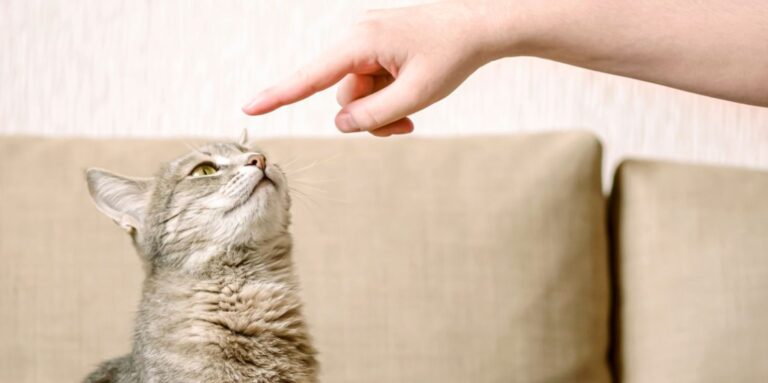At What Age Should You Stop Scruffing A Cat? When Is Too Old?

As cat owners, we often find ourselves mimicking behaviors seen in felines themselves. One of these behaviors is ‘scruffing’ – a technique where the loose skin at the back of a kitten’s neck, known as the ‘scruff,’ is gently gripped, often as a way to safely handle or control them. This practice stems from observing mother cats carry their kittens by the scruff in their jaws. But is this harmless emulation of feline behavior advisable for all ages? When does a cat become too old or too heavy for scruffing?
While some veterinarians are totally against scruffing, others believe it can be helpful if done properly. Regardless of the perspective, this way of grabbing a cat should not be carried on further than the three-month mark as kittens begin to gain weight and grow rapidly, reaching a point where their bodies are too heavy to be safely lifted by the scruff. Continuing to scruff a cat beyond this age can cause them discomfort and potentially lead to injuries, as their bodies aren’t designed to support their full weight by the scruff.
When it comes to handling your feline friend, remember that safety, comfort, and respect for their instincts should always come first. Instead of scruffing, it is generally recommended to handle cats in ways that distribute their weight evenly and allow them to feel secure. In this article, we look into the dangers of scruffing your cat and provide tips on how to properly pick them up without engaging in such practice.
Read Also: When Is A Cat Too Old For Dental Cleaning?
e
Jump to Section
When Should You Stop Scruffing A Cat?
Scruffing a cat is generally not a good practice for humans. It’s something that mother cats do to their kittens, as they are small and light, and it’s a natural way for a queen to keep her kittens safe and under control. However, for humans, scruffing can potentially cause unnecessary stress or injury to a cat, especially if done improperly.
By the time a kitten reaches around 12-14 weeks of age, their body undergoes considerable growth, including weight gain. Consequently, scruffing becomes less suitable and can lead to discomfort, or even pain. The skin on their neck, also known as the scruff, is not designed to bear the full weight of a grown cat therefore, it’s important to adapt your handling techniques as your kitten grows, to ensure their comfort and safety.
Intriguingly, cats are stoic creatures that are notorious for hiding their pain and discomfort, a survival mechanism inherited from their wild ancestors. Thus, your feline companions might not explicitly show if they find scruffing distressing or painful. This reality highlights the importance of empathetic and cautious handling, rather than relying on scruffing. Focus on understanding your cat’s body language and offer them adequate support when handling them instead.
Why You Should Not Scruff A Cat
It’s always advised not to scruff a cat as this can have different effects on them. Below are some consequences of engaging in such behavior.
1. Physical Injury And Pain
When you scruff a cat, you’re holding it by the loose skin at the back of its neck. When an adult cat is scruffed, especially if lifted off the ground, it puts undue stress on its neck and spine. Over time, this can result in chronic pain, muscle strain, or even severe injuries like dislocation or nerve damage.
Remember cats are masters at hiding pain and so might continue to act normally despite being in discomfort or even serious pain. This makes it even more critical to avoid potentially harmful practices like scruffing, as you might not realize when your cat is hurt.
2. Stress/Anxiety
Cats need to feel secure in their environment, and being lifted by their scruff can make them feel extremely vulnerable. This vulnerability can translate into stress and anxiety, disrupting their overall sense of safety and well-being.
Repeated exposure to stressful situations like scruffing can also lead to chronic anxiety. This chronic state can affect their eating and sleeping patterns, their interactions with people and other animals, and their overall health.
2. Aggressive Behavior
Scruffing can trigger aggressive behavior in cats. When they feel threatened or uncomfortable, they may respond defensively to protect themselves. Scruffing can evoke these reactions, leading to behaviors such as hissing, scratching, or biting.
If your cat starts associating human touch with the negative experience of scruffing, it might become generally more aggressive. This could mean they lash out more often, even in situations that previously wouldn’t have bothered them. The effects of this could be widespread, causing problems for both the cat and its human family members.
3. Can Provoke Fear
Fear is a powerful emotion in cats. Being scruffed, especially if it’s associated with pain or discomfort, can lead to fear responses in your cat. They may start to dread being picked up or handled, making everyday tasks difficult and stressful for both you and your cat.
Furthermore, this fear isn’t limited to just scruffing. If they’re scruffed regularly, they might start to fear other forms of physical contact or even the approach of a human. This could result in them avoiding social interaction or becoming more skittish in general, impacting their quality of life.
4. Negative Emotions And Association
Cats have excellent memories when it comes to associating experiences with emotions. If your cat associates scruffing with pain, discomfort, or fear, they might also link the person doing the scruffing with those negative experiences. This means they might start to withdraw from social interaction, appear more anxious, or exhibit less affectionate behavior.
If these negative experiences persist, your cat might even develop a general negative association with humans. They might become more aloof or show signs of distress around people, disrupting the bond between them and their human companions, and leading to a less harmonious household.
5. Distrust
Consistent negative experiences like scruffing can break down the trust between a cat and its owner. Trust is an essential component of a healthy and positive human-cat relationship, and without it, the bond can deteriorate.
When a cat loses trust in its owner, it can lead to more defensive or suspicious behavior. They may be less inclined to seek out affection or play, reducing the joy of companionship for both the cat and the owner.
How To Properly Pick Up A Cat
Picking up a cat properly is important not only for the cat’s comfort but also for their safety. Here’s a more thorough explanation:
1. Approach The Cat Carefully
Before you even think about lifting your cat, it’s important to gauge their mood first. If your cat is sleeping, eating, grooming, or otherwise engaged, it might not be the best time to pick them up. Cats can be quite independent and they appreciate having their space respected.
When you’ve determined it’s a good time, approach your cat slowly and calmly. Quick movements can startle a cat, making them more likely to resist being picked up or even act defensively. Speak softly or use a gentle purring sound to reassure them.
2. Offer Your Hand
Before picking up your cat, extend your hand toward them, palm down, and let them sniff your fingers. This is a non-threatening way to initiate contact and allows the cat to become comfortable with your scent. If they nuzzle or rub against your hand, that’s usually a good sign that they’re comfortable with you.
3. Position Your Hands Correctly
Now, it’s time to lift your cat. Begin by placing one hand under the cat’s chest, right behind the front legs. This hand will bear most of your cat’s weight and keep them secure.
With your other hand, support the cat’s rear end. Slide it under their hindquarters until you’re supporting their weight evenly. It’s important to ensure your cat’s body is balanced, as this makes the lifting process more comfortable for them.
4. Lift The Cat
Once your hands are in position and the cat feels secure, lift them gently but firmly. Use your legs to stand up rather than your back, as this can help avoid accidental injuries to you or the cat.
Draw the cat towards your chest so it can feel your body heat and heartbeat. This can help reassure them and make them feel safe.
5. Hold The Cat Securely
When holding your cat, make sure they’re nestled close to your body. They should feel secure, not as if they’re about to fall. Make sure both their front and back legs are supported.
Ensure your grip is firm but not too tight. Cats don’t like feeling trapped, so while you need to hold them securely enough that they can’t fall or jump down, avoid squeezing them.
6. Monitor Your Cat’s Reaction
Pay attention to your cat’s body language throughout this process. If they start squirming, hissing, or showing any signs of discomfort, it’s a good idea to let them down gently.
7. Lowering The Cat Back Down
When it’s time to put your cat down, do so slowly and carefully. Make sure all four paws are on the ground before you let go completely. This allows your cat to feel secure and stable.
Remember, every cat is different and will have their comfort levels and preferences when it comes to being handled. Always respect your cat’s boundaries and never force them to be held if they’re uncomfortable. Over time, with trust and patience, your cat may become more comfortable with being picked up.
How To Discipline A Cat Without Scruffing
It’s important to know how to correct a cat’s behavior without causing them discomfort or fear. Here are some steps you can take to discipline a cat effectively without resorting to scruffing:
1. Use A Firm Tone
When your cat is doing something it shouldn’t be doing, respond with a firm, clear voice. A simple “No” can often be enough. Cats may not understand the words, but they can pick up on the tone of your voice.
2. Redirect the Behavior
If your cat is engaging in unwanted behavior, like scratching furniture, try redirecting them to a more appropriate activity. For example, if they’re scratching your couch, guide them toward a scratching post instead.
3. Use Positive Reinforcement
Reward your cat when they behave well. This could be through treats, praise, or additional playtime. Positive reinforcement encourages good behavior, making it more likely your cat will repeat it in the future.
4. Ignore Bad Behavior
If your cat is acting out for attention, sometimes the best response is to ignore them. This shows them that acting out won’t get them what they want. Once they’ve calmed down, you can give them the attention they’re seeking, reinforcing that calm behavior is the best way to get what they want.
5. Consistency Is Key
Cats are creatures of habit. By being consistent with your responses to their behavior, they’ll learn more quickly what is acceptable and what is not. If you only respond to their behavior sometimes, they might become confused about what is allowed.
6. Create A Suitable Environment
Make sure your cat’s environment caters to their needs. This includes having enough litter boxes, toys, scratching posts, and safe places to rest. A happy, comfortable cat is less likely to exhibit unwanted behaviors.
Remember, never punish your cat physically. This will only make them fear you, which can lead to more problematic behavior. Patience, understanding, and consistency are the keys to effectively disciplining your cat.
Why Does Scruffing A Cat Paralyze Them?
The roots of scruffing lie in the animal’s behavior and physiology. The phenomenon of cats becoming immobilized, or appearing paralyzed, when scruffed, originates from their early kittenhood. Mother cats or queens carry their kittens by the scruff using their mouths. This behavior triggers a reflex reaction in the kittens called pinch-induced behavior inhibition (PIBI) or clipnosis, causing the cat to remain still and relaxed, ensuring they don’t squirm or fall while being moved. The scruff of a kitten is highly sensitive, and when lifted, their bodies release endorphins that cause a passive reaction, essentially freezing their movement for a moment.
However, it is critical to understand that while this response can be observed in kittens, adult cats don’t necessarily react in the same manner. When a fully grown cat is scruffed, the response can be quite different. Adult cats are much heavier, which translates to more tension or injuries when suspended by the scruff. It can also lead to behavioral issues like fear, anxiety, or aggression.
It’s always important to handle cats with care and respect. If a cat needs to be restrained for grooming or medical procedures, it’s recommended to use other methods that do not cause them discomfort or stress.
Is Scruffing A Cat Abuse?
Whether scruffing is cat abuse or not is left for experts to debate. Some critics argue that, while it’s a natural behavior in mother cats, replicating this action as humans isn’t always received in the same way by the cat while some veterinary experts emphasize its utility in specific scenarios.
For instance, scruffing can be used to protect the cats from potential harm during a particularly aggressive episode or to hold the cat still during a necessary medical procedure. These experts argue that as long as it’s done correctly, gently, and not as a form of punishment, it should not be regarded as abuse.
However, From a psychological standpoint, cats are solitary hunters and may view this handling technique as a violation. This could result in increased anxiety or fear-related behaviors. Physical harm could also result from improper handling, especially in adult cats or overweight cats where supporting their full weight by the scruff could lead to injury.
Regardless, it’s crucial to have a good understanding of cat behavior and handling techniques, and when in doubt, always consult with a professional, such as a veterinarian or a certified animal behaviorist.
Final Thoughts
The age at which to stop scruffing a cat isn’t necessarily set in stone but generally, the practice should be minimized as the cat grows past its kitten stage, usually around 3-4 months old. Beyond this point, the cat’s weight and size increase to a level where scruffing could cause physical discomfort. Furthermore, their cognitive development means they begin to associate actions differently and scruffing could become a source of stress or fear, which can impact their mental wellbeing.
In addition to these considerations, it’s important to bear in mind the specific personality and responses of your cat. Some cats may show signs of discomfort or stress with scruffing earlier than others. Noticing these cues and adapting your handling methods accordingly is key. Learning alternative, more cat-friendly methods of handling can make routine activities such as grooming, bathing, or vet visits less stressful for your cat. Using a cat carrier, for example, is a safe and comfortable way to transport your cat when needed.
As a responsible cat owner, you must observe, learn, and adapt to your cat’s needs as they grow. This approach will ensure a positive relationship with your feline friend based on mutual trust and respect, enhancing their quality of life and your bond with them.
Read related posts about





